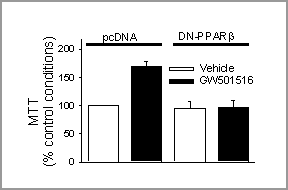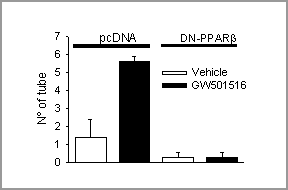PPARß induces endothelial cell proliferation and angiogenesis in vitro New blood vessel formation is required in development, while excessive and inappropiate angiogenesis is seen in tumour growth and in chronic inflammation. The nuclear receptors PPARγ and PPARα inhibit endothelial growth and angiogenesis (Moraes et al., 2005). However, less is know about the role of PPAR β/δ receptors in endothelial cells. Endothelial A549 fusion cell line EAhy926, human umbilical endothelial cells (HUVEC) and human aortic endothelial cells (HAEC) were used in culture. Cell viability was measured by MTT assay and tube formation assay was performed using a three dimensional extracellular matrix (Moraes et al., 2005; Bishop-Bayley et al., 1999). PPAR β/δ expression was measured by Western blot and immunofluorescence. PPAR b/d was activated by the selective ligand GW501615. In some experiments, cells were transfected with dominant negative (DN)-PPAR β/δ (a gift from Dr Toshihisa Hatae; Osaka), using Novafector (Bishop-Bayley et al., 1999), to inhibit PPARβ/δ. EAhy926, HUVEC and HAEC contained PPARβ . Activation of PPARβ by GW501516 (100 nM; 72h) induced endothelial cell proliferation: EAhy926 (fig. 1A), HUVEC, 164±21% and HAECS 180±29% compared to control (p<0.05, one sample t-test, n=4). In cell differentiation assays, GW501516 (100nM) increased the formation of tube-like structures (mean tubes per field, from 5 random fields) at 24h in EAhy926 (fig. 1B), HUVEC (vehicle, 2.0±1.4; GW, 8.6±3.8) HAEC (vehicle, 2.6±1.1; GW, 7.0±0.7) (p<0.05, paired t-test, n=4). Cell proliferation and tube formation induced by GW501516 was prevented by transfection of EAhy with DN-PPARβ but not control vector pcDNA.
Figure 1. Inhibitory effects of DN-PPARβ on GW501516 (100nM)-induced (A) EAhy cell proliferation (72h) and (B) tube formation. Mean ± s.e.mean for n=3 experiments. Activation of PPARβ/δ leads to increased endothelial proliferation and angiogenesis in vitro. PPARβ may represent a new therapeutic target for endothelial cells function.
Moraes, L. et al. (2005). Pharmacol Ther. (in press). |
|



